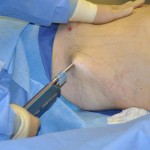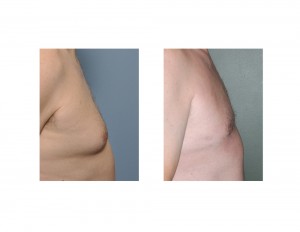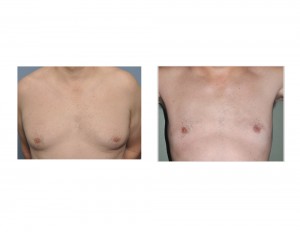Background: Gynecomastia, or male breast enlargement, occurs in a wide variety of forms and ages. While typically perceived as a condition that occurs in teens and young men as a reaction to elevated hormonal levels from puberty, gynecomastia occurs equally in older men as well. ‘Man boobs’ as they are often called can be an aesthetic affliction to any man at any age.

The surgical treatment of gynecomastia consists of only two basic approaches, liposuction or open excision. In many gynecomastia reductions surgeries of all ages, a combination of open excision and liposuction is usually needed. But softer gynecomastias and those thayt have little evidence of any lumps or masses under the nipple will do well with liposuction alone. Many different types of liposuction can be used for gynecomastia surgery and will work equally well based on the practitioner’s skill and experience.
Case Study: This 54 year-old male came for liposuction of the chest, abdomen and flanks…the three classic liposuction areas for men. He had lost as much weight as he could through diet and exercise and had ‘hit the wall’. He needed a surgical boost to make a more significant change than we he could accomplish. His chest had a softer type of breast enlargement that had no hard lu


For many older men with gradual onset gynecomastia, liposuction alone can be a very effective treatment. It is often combined with other body areas such as the abdomen and flanks which many men have problems with as well. Power-assisted liposuction aids in fat and/or breast tissue removal through its oscillating tip, lessening the workload on the surgeon.
Case Highlights:
1) Liposuction is the most common surgical method used for gynecomastia reduction.
2) Men that develop gynecomastia as they age or gain weight are more likely to have a softer less fibrous type of breast tissue.
3) Power-assisted liposuction is an effective method to treat older softer male gynecomastias.
Dr. Barry Eppley
Indianapolis, Indiana



